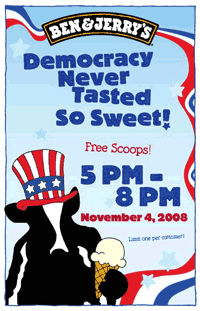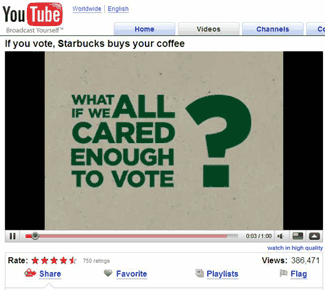Remember the free pancake breakfast you used to get as a kid down at the fire station? Of course it wasn’t free, your parents would pay a donation to help out the firehouse, but it seemed like it was free didn’t it? Your parents likely donated more than they probably would have paid at the local Denny’s for breakfast, yet they too felt it was free; probably even better than free.
This is the sense of community that human beings long for, and this isn’t lost with social media. It’s actually part of the reason for social media’s meteoric ascendancy in our lives.
Face-to-face interaction still can’t be beat, but social media helps you feel part of a community. It even helps you keep an intimate community feel at a national or global level. A good example of this was the day of the 2008 election.
Many past campaigns have tried (and failed) to increase voter turnout (e.g., MTV’s Rock the Vote). Voter turnout this year was already expected to be strong for many reasons, but as a friendly reminder and incentive, several companies gave away freebies.
Most marketers generally steer clear of anything political, but in this case the brand marketers wanted to be a part of a community. The community in this instance, thanks to social media, was the American community.
Some of the more high-profile giveaways included a chicken sandwich from Chick-fil-A, a tall cup of coffee from Starbucks, a free scoop of ice cream from Ben & Jerry’s, and a star-shaped doughnut with “patriotic sprinkles” (i.e., red, white and blue) from Krispy Kreme. This, along with many other factors, helped drive the highest voter turnout since 1908. People had to show their “I Voted” sticker to get their freebie, but in most cases they could simply say they voted (after all isn’t community all about trust?!).
One entity that doesn’t believe in trust is the government. They almost rained on this “feel good parade” by highlighting a federal law that stipulates you can’t give incentives to encourage people to vote. Fortunately, these creative companies didn’t let this hurdle stop them and were able to work within it.
That’s another thing we’re seeing with the advent of SocialnomicsTM — it’s a new way of thinking. In the past, big companies like this would have been shrinking violets and let their well-paid legal counsel pontificate on doomsday scenarios and suck the enthusiasm out of the marketing and public relations departments until they gave up on the idea.
We’re seeing less of this, in part due to intense competition. Companies are adapting the mantra: “If we don’t do this, someone else will.”
Part of this competition is coming from foreign entities that don’t have the same legal requirements. Most of all, though, we’re seeing companies and people within companies having a better sense of reality and not always playing everything by the letter of the law. If a company believes what they’re doing is right, then they’ll overcome the hurdles.
Contributing to this, in part, is the flexibility and real-time nature of social media. In the past if Ben & Jerry’s promoted a free-giveaway via the expensive development of television, radio, and print advertising, they had to think twice about the costly concerns of the law shutting down their good intentions.
However, because the primary push for this promotion meant alerting their followers on the Ben & Jerry’s Handmade Inc. Facebook fan page, there was little upfront costs. Also, it would only take about 20 to 30 minutes of work to take down the promotion.

They let their 285,000 fans spread the word virally. As we constantly harp on within social media, it’s not how cool Ben & Jerry’s is, but whether they can give their loyal fans something to pass on that makes those fans look cool. Ben & Jerry’s added more than 100,000 fans to their Facebook fan page during the promotion, resulting in 385,000 fans today.
Starbucks also almost exclusively promoted their coffee giveaway via social media mechanisms. They ran only one ad on “Saturday Night Live,” which was primarily viral during the time as a result of the success of Tina Fey’s Sarah Palin spoofs (more than 50 percent of the views were within social media). They also ran :30 TV spots on Hulu and display placements on Facebook.
The spots took advantage of the well-known Starbucks recycled brown paper coffee sleeve to animate and script a quick message helping to convey two salient points — we care about the environment and we care about the country. The message was “What if we cared so much every day about these things?”
In a rare instance, it covered branding (what Starbucks stands for) and also gave a call to action (come to our store).

It’s estimated that Starbucks spent less than $400,000 for this promotion, which Oprah quickly paid back by giving it some major coverage on her show, as did many other media outlets. Starbucks’ viral buzz increased 26 percent as a result of this effort.
While Starbucks wouldn’t disclose how much coffee was given away, in some stores it was plenty: one Chicago franchise handed out 300 steaming cups of Java and goodwill. Facebook users also started downloading the application “Which Drink is Meant for You” resulting in almost 100,000 active monthly users and the Starbucks fan page is close to 200,000 fans.
In order for companies to truly benefit from social media they have to become part of the community. Is your company serving up fresh pancakes or stale messaging?

